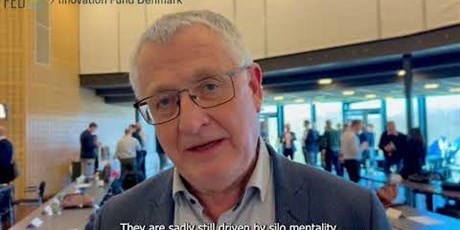The digitalisation project Flexible Energy Denmark has proven the value of data liberation across energy systems. The project has also increased our understanding of how to utilise energy flexibility in buildings and in district heating systems. Intelligent management of energy consumption has shown savings of between 5 and 30 percent.
The consumption of energy increases with the electrification of society. This is a challenge, when fossil fuels are supplanted by solar and wind energy, which varies not just during the year but across 24 hours. But the transition to green energy can become both cheaper and easier if Denmark learns to exploit the possibilities of flexible energy usage. This understanding is one result of the digitalisation project Flexible Energy Denmark (FED), which brings important new knowledge to both the energy sector at large and the politicians creating the framework for how utility companies act and how the energy system is constructed.
With funding from the Innovation Fund Denmark, DTU Compute and DTU Management together with the Danish universities AAU, AU and SDU, utility companies, municipalities and businesses have collaborated on developing digital solutions which create energy flexibility in buildings and in district heating systems. During the energy crisis consumers have become aware of this flexibility. The FED project has added to the current agenda, and the researchers believe data driven automation of energy consumption is the future.
Head of Section at DTU Compute, Professor Henrik Madsen, is the lead scientist on the FED project. He commends his colleagues from DTU, SDU, Aarhus University and Aalborg University for having published more than 50 scientific papers, despite facing Covid-19 lockdowns and a lack of measuring equipment because of a global chip-manufacturing crisis, bringing the important knowledge gained in the project to the world:
“The FED project has truly given us an understanding of flexibility. How to understand and describe flexibility but also how to use it in the weather-driven energy systems of the future so we can balance our energy consumption and avoid laying any more expensive cables than strictly necessary. In this context, the techniques developed in the FED projects offer us unique possibilities. But we still lack the right framework and the legislation needed to get away from the silo mentality of looking at electricity, water, and heating as separate and independent energy demanding systems instead of integrating them and using their ability to be flexible.”
Data liberation
The fulcrum of Flexible Energy Denmark has been easy access to consumer and energy production data through the digital hub for intelligent energy systems called ‘Center Denmark’, which the FED partners established early on. Being able to extract data about current energy consumption from this ‘data lake’ in the hub was essential, according to Lars Bonderup Bjørn, CEO of EWII and Chairman of the FED steering committee:
“The FED project has shown the immense value of data liberation. A crucial insight that this project has generated: We can now put into words what data liberation does. The project has also shown the value of flexibility and has developed in a time where flexibility has become increasingly relevant. We are facing an explosion of potential in utilizing flexibility and I am so proud of what this project has shown in terms of energy consumption.”
By analysing real consumer data about electricity, water and heating along with data from six living labs (including schools, residential areas and holiday homes) researchers have shown significant energy savings by starting or stopping energy demanding processes, according to the availability or lack of surplus energy in the grid and the surrounding community.
One example is a mixing loop in the city of Aalborg which has been able to lower it’s temperature by 20 degrees in the district heating system by using consumer data to create a prognosis. This exercise has reduced heat loss significantly without loss of comfort. It has also allowed Aalborg Forsyning to integrate more renewables into the district heating while helping the residents save money.
At Fredericia Fjernvarme data from consumption meters has informed new methods of lowering temperature as well. Demonstrations at several district heating plants have shown such methods to be able to reduce heat loss with as much as 20 percent. This helps consumers financially but also lowers emissions of CO2.
In the city of Blåvand the management of heating in Novasol holiday homes with indoor pools, have reduced costs by as much as 29 percent, by shifting the heating to the cheapest six hours of the day.
National and international impact
"The FED project has truly given us an understanding of flexibility. How to understand and describe flexibility but also how to use it in the weather-driven energy systems of the future so we can balance our energy consumption and avoid laying any more expensive cables than strictly necessary."
Henrik Madsen, Professor and Head of section at DTU Compute, Lead Scientist for Flexible Energy Denmark
Knowledge from the project has also found its way into energy policy discussions and reports nationally as well as internationally where the methods are recognised as an important new technology in utilising flexibility in buildings and energy communities, to secure better integration of solar and wind power and to create a better management of distribution grids for both electricity and heating.
Apart from the Center Denmark hub the project has also established the platform uni-lab.dk which gather Danish living labs and test facilities to make is easy for businesses to find relevant partners and real-world data to develop new, digital products. Although the project is coming to an end the work with energy policy continues – and the six living labs live on under the auspices of other projects.
Some solutions have already found their way to the market. A method to monitor and manage the indoor climate, developed at a living lab in Høje-Taastrup, is already in use in schools and offices in Denmark and is on its way to Hong Kong and the US.
The video below is from Flexible Energy Denmark's closing conference, March 2023.


Selected major results of Flexible Energy Denmark
- The creation of Center Denmark, a digital hub for intelligent energy systems. Energy and energy related data constantly enters and exits this state of the art platform which can store and share this data minute by minute in a secure manner so the it can be utilised by both utility companies for energy management and by businesses to develop new commercial solutions.
- The creation of six living labs in Aalborg, Aarhus, Fredericia, Kolding, Blåvand and Høje-Taastrup.
- The creation of Uni-Lab.dk, which assembles all the living labs and test facilities in Denmark.
- More than 50 scientific articles have been published.
- The development of methods for virtual energy storage through the digitalisation and coupling of energy system sectors.
- The development of methods to monitor and digitise utility companies.
- Contributed to the energy policy of Denmark and the EU, and both national and international scientific communities with knowledge about why and how flexibility and be utilised in buildings and in district heating.
Selected results from the six living labs
- The development of wind power forecasting methods which have shown improvements of 20 percent in pricing area DK1.
- Temperature in district heating was lowered by 20 degrees in a residential area by using an intelligent mixing loop, which can manage the district heating system based on forecasts, the expected heating demands of buildings and consumption data. This has reduced heat loss significantly without loss of comfort, makes the integration of more renewables in district heating possible while saving consumers and the utility company money.
- The development of a data driven Digital Twin for Dynamic Transformer Rating, which makes upgrading wind power farms possible by up to 60% without having to upgrade the transformer.
- The development of new methods for data driven management of temperatures in centralised district heating by using meter data. Between 4% and 20% heatloss avoided.
- The development of new methods to predict heating load in district heating with 10% to 40% improvement.
- Optimisation of heating management of holiday homes with pools. Houses able to heat up the pool during the cheapest six hours reduced their costs by 29%.
- The development of new methods of controlling indoor climate, reducing unhappiness with indoor climate as much as 50%.